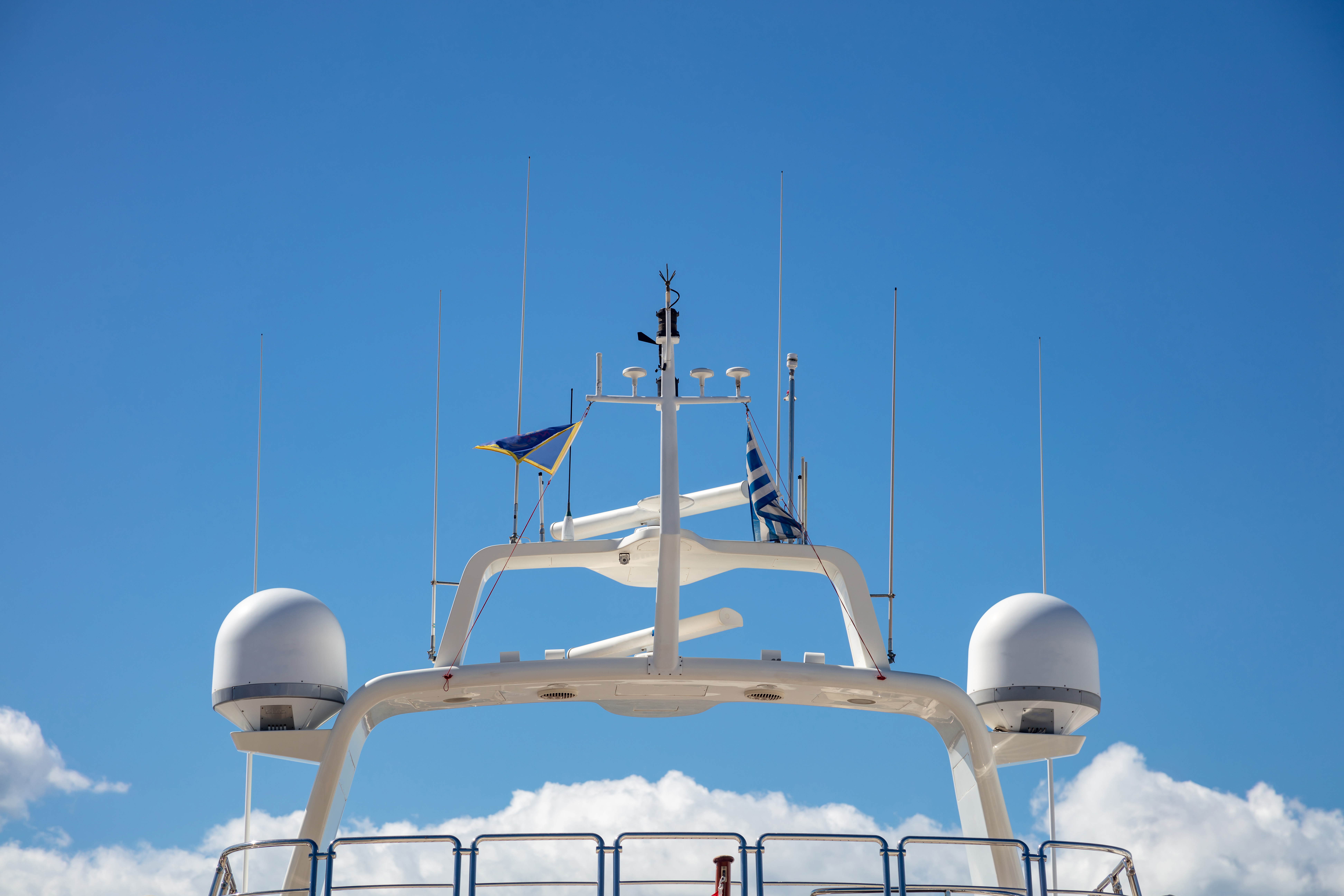What is Radar?

Radar is a shortened term for Radio Detection and Ranging. They are instruments which detect surrounding objects by transmitting RF energy and receiving small energy reflections off of these objects. As Radars use microwaves which are considered short wavelengths, it means the accuracy is very high. The reflected energy indicates the direction and distance from the Radar to the object.
Radars operate on a ‘line-of-sight’, meaning that there should be no obstructions around the Radar. Having objects such as masts and other antennas in front of the Radar will result in the signal hitting these objects and reflecting back, giving false targets, and creates ‘shadow zones’, which are essentially black spots on the Radar display.
The installation of a Radar is something which must be carefully thought through, and there are some points which should be considered and followed when installing one:
- The Radar should be mounted above and out of the way of the crew. Radar beams are focused energy that can be harmful to humans.
- There should be no obstructions for the Radar on Critical Azimuth Bearings.
- If more than one Radar is present, they require vertical separation. Radars should be clear of each other’s vertical beamwidth. (Minimum 45cm vertical separation)
- The installation and mounting location should be capable of supporting 6x the weight of the antenna.
- The recommended installation should be 8ft above deck, and no higher than 30ft above the water, so that close-range targets do not get overlooked.
The microwaves transmitted from a Radar travels in an almost straight line, and when this wave hits an object it is reflected back to its original position. This principle is constant through all Radars, where the reflected wave is what is used to determine certain measurements. The ‘brains’ of the Radar use this information to give the user an accurate display of targets.
The distance of the object from the vessel is calculated by the time taken for the reflected wave to bounce back to the radar. The longer the time taken for the reflected wave to return, the further away the object is. The distance is determined using the following calculation:
D = ½ * (c*T) or D = (c*T) / 2
D = Distance between Radar and object
c = Speed of Light
T = Time between transmission of wave and reception of reflected wave
As the Time (T) is for a complete trip of the microwave, it must be divided by two, to determine the distance between the Radar and the object otherwise you’d end up with double the distance, resulting in invalid target displays which could put you and other boats in danger.
There are two types of Radar, Dome and Open Array. Dome Radars typically have a larger beam width in comparison to Open Arrays. Usually (although this is not always the case), Dome Radars are found on smaller, noncommercial vessels, and leisure crafts. They weigh less, are cheaper, and use less power depending on the strength of the Radar.
Open Array Radars on the other hand are often found on military, commercial, and long-range trawler vessels that are bird-finding. Typically, Open Array Radars are more powerful, allowing targets at a farther distance to be identified. The narrower beam angle also gives better distinction and targets where multiple objects are in close proximity to one another. However, the cost and weight are a counterargument to these.
Radars are defined into 2 bands, S-Bands and X-Bands. These two bands are at different frequencies, and thus they are both beneficial, depending on the scenario.
S-Bands have a 2-4GHz Bandwidth and longer wavelengths than that of X-Bands. Due to the longer wavelength and lower frequency, they are attenuated less, meaning they can detect targets at farther distances than X-Bands. Interestingly, S-Band waves are not reflected well by water, making them great for marine navigation.
X-Bands operate on an 8-12GHz Bandwidth, which has a much shorter wavelength than the S-Band. Thanks to the shorter wavelength, the waves are straighter and reflect better. Essentially, the shorter the wave, the more accurate the Radar Antenna is. Whilst this is beneficial, it does mean they are limited in range in comparison to S-Bands. Because of this, they are commonly used together, giving the vessel the best coverage for long-range targets, whilst providing close-range accuracy.
Radars can have a variation in detection range depending on the beam angle and power etc.… but there is one key factor that will always determine how far a radar can detect; Installation Height.
Waves from the Radar can be affected by diffraction, which causes them to curve slightly along the surface of the Earth’s curvature. This effect allows Radars to ‘see’ past the line-of-sight of the Human Eye. Generally, the diffraction allows the Radar to go roughly 5% further than line-of-sight. Whilst we can only see up to the visible horizon of the Earth, the Radar is capable of identifying objects and targets past this. The calculation for this is:
D = (√A1 + √A2) * 2.2
D = Radar line-of-sight distance
A1 = Height of Radar installation
A2 = Height of object reflecting wave
By increasing the height of the Antenna installation, you in turn, increase the line-of-sight distance of the Radar. Of course, changing the height of the object reflecting the wave would also increase the line-of-sight range… but you cannot increase the height of a cliff face.
Radar has been around a long time now. The founder of Actisense, Phil Whitehurst, originally worked alongside one of the pioneers of radar during a spell at classic marine electronics company Echopilot. There he worked for Harold Whitfield, who was a team member on the Robert Watson Radar team who was responsible for the massive success of the RAF in WW2. That technology then went on to become a vital part of the navigation equipment on many boats, particularly those who travel beyond the sight of land.





